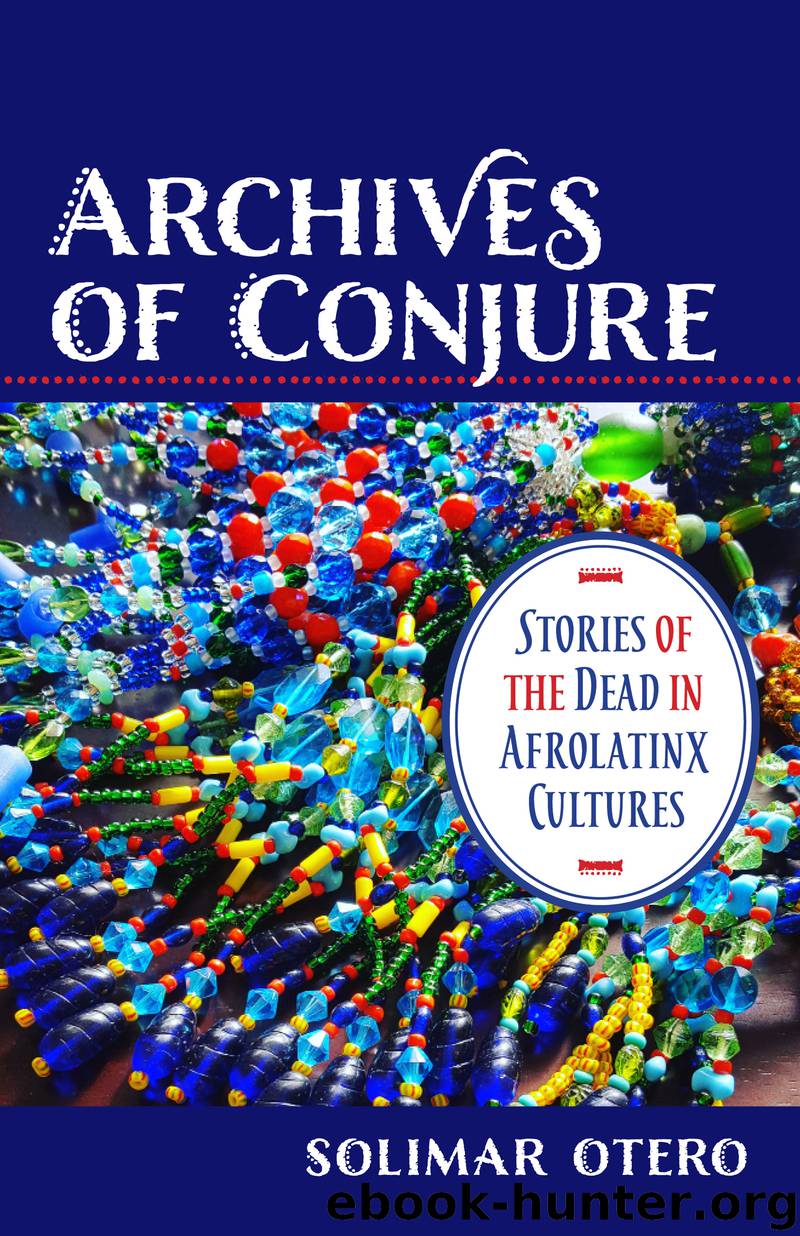Archives of Conjure by Solimar Otero

Author:Solimar Otero
Language: eng
Format: epub
Publisher: Columbia University Press
4
SIRENS
Ce qui existe par totalité relativisée.
—Édouard Glissant, Le discours antillais
What stories are told about materially fluid beings in archives of conjure? In this chapter, I investigate how hybrid bodies are understood in Afrolatinx mythology, folklore, and literature using a Caribbean ritual poetics. I show how these poetics destabilize universalizing subjectivities by paying attention to feminist and queer expressions of sexuality. In Afrolatinx religious cultures, the captivating transgendered oricha of Erinle (Inle) is central to thinking about these considerations.1 By investigating traditional narratives and the fiction of Mayra Santos-Febres, a complicated set of attitudes and aesthetics emerges, revealing components of sexual violence, desire, trauma, healing, and ethnic connotations of difference. Taking this legacy of “reading” further, this chapter also discusses how figures like Erinle continue to influence Caribbean queer folk and popular culture in ways that emphasize the deep relationship between mythology and performance.2 I am using queer here to express nonheteropatriarchal forms of expression and becoming, especially in public sphere performances that emphasize feminine verbal agility and stage presence, like Yoruba oríkì and transformista’s lip sync traditions.3
Erinle is an ancient river divinity hailing from Nigeria. He is recognized as the tributary of the Ọṣun River, which supplies most of the water to Oshogbo state (Drewal, Pemberton, and Abiodun 1989:156). His name is translates to erin, elephant, on ile, earth (Mason 1994; Abraham 1958:162–63).4 He was the first oloba (king) of the town of Ilobu, where Erinle’s shrines hold smooth river stones in clay vessels to commemorate his riverine origins (Abraham 1958:304; Drewal, Pemberton, and Abiodun 1989:167; Adepegba 2001:104). In Nigeria, devotes of Erinle are known by their names that start with omí, water, such as Omíyalé, “water rushes into the home” (Abraham 1958:474). Abata is a divinity of the marshes and swamps that is closely associated with Erinle, sometimes as an (androgynous) partner, in Nigeria and Cuba alike (Abraham 1958:474; Tsang 2013:116; Ramos 1996:63; Conner and Sparks 2004:78; Cabrera 1980:88).5 In Africa, Erinle’s fluidity is centered on how the deity moves between the forest and the river in an amphibious manner. Oral tradition tells of how Erinle, a skilled hunter and fisherman, saves the town of Ilobu from Fulani invasion and later returns to live in the river named after him (Drewal, Pemberton, and Abiodun 1989:167; Abraham 1958:164). He is associated with great traditions of sculpture, with male ritual traditions surrounding the hunt, and with female ritual traditions of healing with river water. Erinle’s own archive of conjure illustrates a scattering of affects where he crosses borders and creates alliances based on transgression.
Lydia Cabrera describes Erinle (Inle) as, “Médico, cazador y pescador, es para muchos una divinidad andrógina, Inle Ayayá vive en la tierra y en el agua” (Doctor, hunter, and fisherman, he is for many an androgynous divinity, Inle Ayayá lives on the earth and in the water) (1980:87). Erinle’s fluctuating nature inspires an array of interpretations in Afrolatinx religion linking the deity to the orichas Yemayá, Ochún, Ochosi, and Ifa. As Cabrera asserts, in Santería he is primarily
Download
This site does not store any files on its server. We only index and link to content provided by other sites. Please contact the content providers to delete copyright contents if any and email us, we'll remove relevant links or contents immediately.
| African | Asian |
| Australian & Oceanian | Canadian |
| Caribbean & Latin American | European |
| Jewish | Middle Eastern |
| Russian | United States |
4 3 2 1: A Novel by Paul Auster(11047)
The handmaid's tale by Margaret Atwood(6852)
Giovanni's Room by James Baldwin(5877)
Big Magic: Creative Living Beyond Fear by Elizabeth Gilbert(4723)
Asking the Right Questions: A Guide to Critical Thinking by M. Neil Browne & Stuart M. Keeley(4574)
On Writing A Memoir of the Craft by Stephen King(4213)
Ego Is the Enemy by Ryan Holiday(3991)
Ken Follett - World without end by Ken Follett(3972)
The Body: A Guide for Occupants by Bill Bryson(3800)
Bluets by Maggie Nelson(3709)
Adulting by Kelly Williams Brown(3669)
Guilty Pleasures by Laurell K Hamilton(3586)
Eat That Frog! by Brian Tracy(3514)
White Noise - A Novel by Don DeLillo(3434)
The Poetry of Pablo Neruda by Pablo Neruda(3366)
Alive: The Story of the Andes Survivors by Piers Paul Read(3310)
The Bookshop by Penelope Fitzgerald(3225)
The Book of Joy by Dalai Lama(3217)
Fingerprints of the Gods by Graham Hancock(3212)
